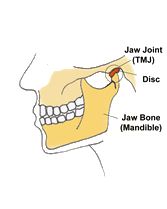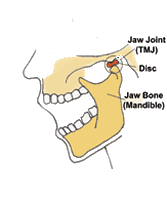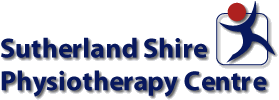|
|
 |
|
| |
| Jaw Problems (TMD) |
 |
|
|
Jaw pain is a very common problem. The condition is sometimes known as TMD (Temporomandibular Disorder) or TMJ Disorder (Temporomandibular Joint Disorder). Around 70% of the population may experience some jaw symptoms from time to time. These symptoms can range from mild discomfort to severe pain with jaw restriction and locking. Pain may be felt in the jaw joint, jaw bone, teeth, jaw muscles, temple region, ears and neck. This condition can also cause headaches, dizziness and intermittent deafness. TMD can have a devastating effect on your life, interfering with eating, laughing, yawning and even talking.
The temporomandibular joint (TMJ) is the joint that allows you to open and close your mouth. If you put your fingers just in front of your ears and open and close your mouth you will feel the TMJ moving. The TMJ is a very mobile joint that can move forwards, backwards, side to side, up and down.
Strong muscles and ligaments around the jaw work together to both stabilise and move the jaw. This allows you to bite and chew, talk and yawn. There is also a long fibrous disc running through the joint that helps to align and stabilise the joint. All these structures need to work together correctly to maintain good jaw function.
Causes of Jaw Pain
- An injury, such as a blow to your jaw or a fall onto your chin, or a whiplash injury in a car accident
- Surgical procedures to the mouth, throat, stomach or lengthy dental procedures, where the jaw has been held open for an extended period of time
- Clenching or grinding your teeth (bruxism)
- Upper and lower teeth not meeting together properly (mal-occlusion)
- Missing several teeth in a row
- Arthritis or joint damage in the TMJ
- Neck postural problems
- Stress
- Resting your chin on your hand as you work
- Dislocation or pinching of the disc in the jaw joint, this can cause locking or clicking of the joint
- Mal-tracking of the jaw due to muscle over-activity or muscle spasm, this may also cause clicking in the joint
Symptoms
- Pain in the jaw joint and jaw muscles
- Pain in the neck and temples
- Tooth pain or pain along the jaw or gum line
- Headache
- Dizziness
- Swelling over the TMJ and cheeks
- Restricted jaw movement
- Tightness or spasm in the muscles around the jaw and face
- Deviation of the jaw to one side when moving or at rest
- Jaw locking
- Clicking, clunking, grating, popping sounds in the jaw
- Ear pain or a feeling of fullness in the ears
- Ringing in the ears (tinnitus)
- Intermittent deafness or reduced clearness of hearing
|
|
|
 |
.jpg) |
 |
 |
Mouth Closed
When the jaw is closed the disc sits comfortably within the jaw joint. |
 |
 |
Mouth Open
When the jaw opens the disc slides forward to help the jaw open smoothly, in the correct alignment, without dislocating. |
|
Diagnosis
Making an accurate diagnosis of your TMD condition is essential so an effective treatment regime can be implemented for your particular symptoms. Our physiotherapists will assess your jaw joint and muscles, your neck and your posture. An Xray, CT or MRI Scan can also be helpful if there are signs of wear and tear or damage within your joint.
Treatment
In most cases TMD will settle very well with a little physiotherapy treatment. Our treatment is successful in managing most cases of TMD even when the symptoms are long standing and severe. Treatment will be specific to your symptoms and may include techniques to relieve pain, swelling and muscle spasm and restore jaw movement and alignment. It is also important to treat any associated neck pain and headaches and to improve neck posture. Some people with TMD have a neck forward posture. As the neck goes forward the jaw muscles drag the jaw backwards, causing strain to the jaw joint and eventually pain, swelling and irritation.
With physiotherapy most people will see a significant improvement in their symptoms within 3 to 6 weeks.
If you grind or clench your teeth or if you have malocclusion problems then your dentist may need to make you a night splint (occlusal splint). The splint will hold your jaw joint slightly apart while you sleep even if you are clenching, preventing compression of your jaw joint. This helps your jaw muscles to relax and reduces the swelling and inflammation in your joint.
If you have other dental problems, such as cavities, that are causing pain, you may be chewing on the other side only. With time this will cause irritation and damage to the side being overused. You will need to have these dental problems fixed to prevent a recurrence of the TMD. If your pain is severe or you have jaw movement limitation you may need a course of physiotherapy first, so that you can hold your jaw open for your dentist to treat your dental problems.
Self Help
- When your pain is severe, avoid eating food that requires heavy chewing such as steak, nuts and crunchy apples. Try peeling and slicing apples and cooking crunchy vegetables like carrots. Avoid big burgers and sandwiches that make you open your jaw too wide and avoid chewing gum and hard lollies. Try dipping crunchy bread or toast into soup to soften it.
- Improving your posture will help to reduce the tension that develops in your muscles.
- Make sure your tongue is in the correct resting position. Having your jaw and tongue in the correct position will improve your neck posture and make breathing, swallowing and relaxing easier. The tip of your tongue should sit on the little ridge just behind your top teeth, not against your teeth, and then the rest of your tongue should flatten out across the roof of your mouth. Keep your teeth just slightly apart and your lips together. Your tongue should create a small amount of suction which will help to keep you in the correct position. Relax and breathe through your nose. To help you remember this, think “TLC” “T” for tongue position, “L” for lip position, “C” for calm and relaxed.
- Breath through your nose as much as you can. If you always breathe through your mouth or you have a blocked nose, you may find nose breathing quite challenging to begin with, but practice regularly and it will start to feel more normal.
- If you think you might have sleep apnoea, see your doctor and have sleep studies done. Controlling sleep apnoea will improve your general health and reduce your head a neck pain significantly.
- Avoid biting your nails as this places a lot of stress on your jaw joint.
- Avoid holding your phone between your head and your shoulder. If you are on the phone a lot, consider using a headset.
- Avoid resting your chin on your hand when you are sitting.
- Improve your neck posture, avoiding slouched positions. Make sure your work space is correctly set up, see Good Posture - Computer Use.
- When yawning, only open your jaw as far as you feel comfortable. Try placing your hand under your chin gently to remind yourself not to open too far.
- Avoid sleeping on your stomach as this can put your jaw in an awkward position.
- Make sure your pillow is comfortable. If you are waking in the morning with more pain than you had going to bed then chances are your pillow is causing you problems. See Advice for Buying a New Pillow for more information on pillows.
- Reduce clenching and grinding with relaxation, improved posture and stress management. Discuss with your dentist whether a night splint would be appropriate for you.
- It is important to try to identify your stresses so you can plan to reduce or eliminate them. Some situations can be changed or improved. Sometimes you will find yourself in a situation that is not able to be changed, however, you can change how you respond to these situations.
- Seek help. There is a lot that can be done to manage your pain. You don't have to put up with it.
At Sutherland Shire Physiotherapy Centre we have expertise and many years experience in the treatment of jaw problems, headache, postural problems and conditions of the neck, back and upper limb. Heather and Gillian have both undertaken further training and education in the assessment and treatment of TMJ and related neck conditions.
Call today to schedule an appointment with one of our physiotherapists.
If you are a GP, physiotherapist or other health professional and would like more information on temporomandibular disorders go to www.physio-pedia.com or click the following links for articles written by Heather Mariner.
Temporomandibular Disorders
Bruxism and TMD
TMJ Anatomy
Last updated: 1st August, 2020
Please note that the above information is of a general nature and is not intended to substitute for professional advice. You should always seek the advice of your qualified health practitioner to attain a proper diagnosis before starting any treatment regime.
[Return to Top]
References
- Saladin, KS; Human Anatomy. New York, NY: McGraw-Hill. ISBN 0-07-039080-0, 2005.
- Gray’s Anatomy, 40th edition, Elsevier, Churchill Livingstone, 2008.
- Miloro, M; Ghali, GE; Larsen, P; Waite, P; Peterson's principles of oral and maxillofacial surgery, Volume 2, Chapter 47, 2004.
- Kuttila, S; Kuttila, M; Le Bell, BY; Alanen, P; Suonpaa, J. Recurrent tinnitus and associated ear symptoms in adults. Int. J. Audiol., 44:164-70, 2005.
- Ren, YF; Isberg, A. Tinnitus in patients with temporomandibular joint internal derangement. Cranio, 13:75-80, 1995.
- Ramírez, LM; Ballesteros, ALE; Sandoval, OGP. A direct anatomical study of the morphology and functionality of disco-malleolar and anterior malleolar ligaments. Int. J. Morphol., 27(2):367-379, 2009.
- Cheynet, F; Guyot, L; Richard, O; Layoun, W; Gola, R. Discomallear and malleomandibular ligaments: anatomical study and clinical applications. Surg. Radiol. Anat., 25:152-7, 2003.
- Eckerdal, O. The petrotympanic fissure: a link connecting the tympanic cavity and the temporomandibular joint. Cranio, 9:15-22, 1991.
- Kim, HJ; Jung, HS; Kwak, HH; Shim, KS; Hu, KS; Park, HD; Park, HW; Chung, IH. The discomallear ligament and the anterior ligament of malleus: an anatomic study in human adults and fetuses. Surg. Radiol. Anat., 26:39-45, 2004.
- Wright, EF; Bifano, SL. Tinnitus improvement through TMD therapy. J. Am. Dent. Assoc., 128:1424-32, 1997.
- Rowicki, T; Zakrzewska, J. "A study of the discomalleolar ligament in the adult human." Folia Morphol. (Warsz). 65 (2): 121–125, 2006.
- Loughner BA, Larkin LH, Mahan PE. Discomalleolar and anterior malleolar ligaments: possible causes of middle ear damage during temporomandibular joint surgery. Oral Surg Oral Med Oral Pathol. Jul; 68(1):14-22, 1989.
- Langendoen, J; Müller, J; Jull, GA, Retrodiscal Tissue of the Temporomandibular Joint: Clinical Anantomy and its Role in Diagnosis and Treatment of Arthropathies, Manual Therapy, 2(4), 191-198, 1997.
- Bogduk, N. The Anatomical Basis for Cervicogenic Headache. J Manipulative Physiol Ther. 15:67-70, 1992.
- Mark, BM; Kessler, CS, All Pain is not the Same, A unique Perspective on Headaches, TMJ Disorders and Facial Pain, JimSam Inc., 2010.
- Peterson, C. The TMJ Healing Plan, Hunter House, 2010.
- Read, K. Course Notes, Craniomandibular Disorders for Physiotherapists, Uni of Qld, Sept, 2009.
- St George, F; Elliott, P, Course Notes: TMJ / Cranial Techniques, Physiotherapy Coaching Academy Australia, 2011.
- Zito, G. Difficulties with the Differential Diagnosis of Cervicogenic and Temporomandibular Headache, MPA In Touch, Issue 2, 2008.
|
|
|
|

